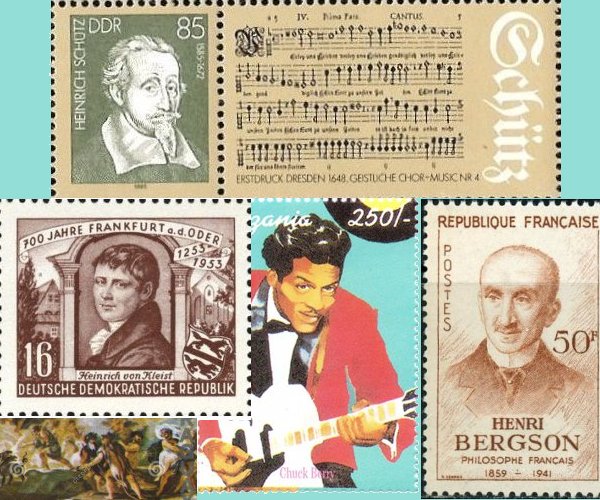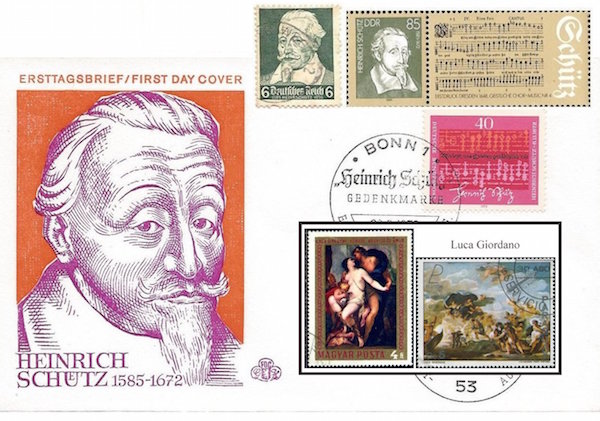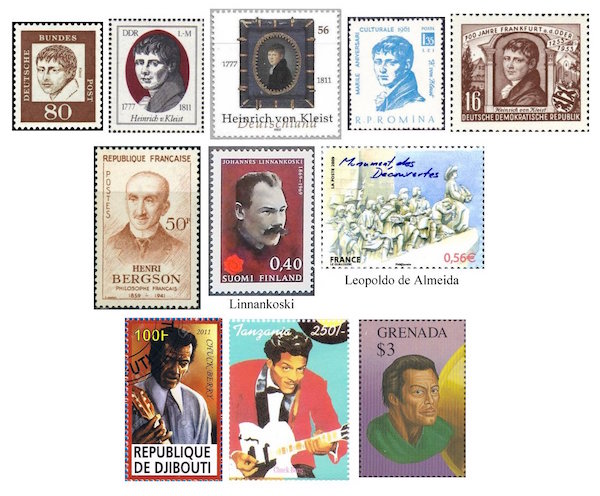The Arts on Stamps of the World —October 18
An Arts Fuse regular feature: the arts on stamps of the world.

By Doug Briscoe
It’’s a short program today, with German composer Heinrich Schütz, Italian painter Luca Giordano, German writer Heinrich von Kleist, French philosopher Henri Bergson, Finnish writer Johannes Linnankoski, Portuguese sculptor Leopoldo de Almeida, and rock and roll progenitor Chuck Berry making up our entire contingent.
Heinrich Schütz was born on this day (O.S. 8 October) in 1585. He wrote mostly sacred music and is held to be the most important of the precursors of Bach. His opera Dafne (1627) is likely the very first German opera, although its music has not survived. He studied in Italy with Giovanni Gabrieli and thus imbibed Italian influences, nowhere more clearly exhibited than in his Opus 1 book of madrigals, published at Venice in 1611. During a second visit to Venice in 1628, he met and studied with Monteverdi. He died of a stroke at the age of 87 on November 6, 1672. The envelope at the center of the image is what we philatelists call a “first day cover”, cancelled on the day of the stamp’s issue, which in this case was September 29, 1972, anticipating the 300th anniversary of Schütz’s death.
The son of a painter, Naples-born Luca Giordano (18 October 1634 – 12 January 1705) came to be known as Luca fa presto, “Luca works quickly” as well as Fulmine, “The Thunderbolt” and, because of his facility at imitating other painters, “The Proteus”. After studies in Rome, Parma and Venice, he painted frescoes and ceilings in Florence (1682-83) and was invited in 1692 by Charles II of Spain to come to that country, where he remained for a decade. He returned to his home town in 1702 and died there three years later. Giordano was known for his open-handed philanthropy, especially to artists in need. He also worked as an engraver in his youth. For stamps we have Venus, Adonis, and Cupid and Pluto and Proserpine.
After a skimpy early education, German writer Heinrich von Kleist (18 October 1777 – 21 November 1811) went into the army and took part in the action against revolutionary France. Then he went in for law and philosophy at his home town of Frankfurt an der Oder and entered government service before throwing it all up for a taste of travel and trying his hand at literature. After his wanderings in Germany, Switzerland, and France (where he was detained under suspicion of espionage), he co-founded a journal in Dresden and settled in Berlin. All of this seems pretty random, but in fact Kleist had conceived a plan for his life when he was 21. All this while he was writing plays and short narrative fiction, along with essays on aesthetics and psychology. Shortly after arriving in Berlin he met a kindred spirit in Henriette Vogel, who was terminally ill with cancer. Apparently it was she who had the idea of entering into a suicide pact with him. Vogel, reluctant to take her own life, found a willing executioner in the morose Kleist. (So I guess the plan was: wander more or less aimlessly and write a lot. The suicide was a deviation from the plan.) Musical adaptations of Kleist’s work include a symphonic poem and an opera on Penthesilea (1808) by Hugo Wolf (1883-95) and Othmar Schoeck (1927) respectively, incidental music for Das Käthchen von Heilbronn (again 1808) by Hans Pfitzner (1905), and an opera on Der Prinz von Homburg (1811) by Hans Werner Henze (1960). A respectable number of films based on Kleist have been made, perhaps most notably Éric Rohmer’s 1976 film The Marquise of O and Volker Schlöndorff’s dramatization of Michael Kohlhaas, both based on Kleist novellas. A final minor observation: Here we have five different stamps from three different countries (East and West Germany and Romania), and every single design uses the same portrait at its center. A bit unusual.

As a rule, philosophers get the cold shoulder here on AoSofW, but Henri Bergson (18 October 1859 – 4 January 1941) earns a pass because he won the Nobel Prize in Literature in 1927. Besides, his wife was a cousin of Proust, who was Bergson’s best man at the wedding.
Finnish writer Johannes Linnankoski (October 18, 1869 – 10 August 1913), born Vihtori Johan Peltonen, got his start in journalism and began to focus on translation right around the time of his marriage in 1899. His first work of fiction appeared, under the Linnankoski (LIN-an-kos-ki) pen name, in 1903. It was in 1905 that his most important novel, The Song of the Scarlet Flower, was published. There after he added several plays to his fiction output. He died of anemia at age 43.
Only a small section of Lisbon’s Monument to the Discoveries (Padrão dos Descobrimentos) can be seen on the French stamp of 2009. Why a French stamp? you may reasonably inquire. It’s one of a series paying tribute to European cities, and the monument is situated in the native city of one of its designers, sculptor Leopoldo de Almeida (18 October 1898 – 28 April 1975). The work, a co-creation with designer and polymath Cottinelli Telmo (1897-1948), was created in 1940 for the 500th anniversary of the death of Henry the Navigator. It seems that de Almeida (18 October 1898 – 28 April 1975) was in his mid-20s before he traveled outside Portugal to France and Italy. Shortly after his return he colaborated in another monument, one to the 18th-century Portuguese statesman and prime minister the Marquês de Pombal; this had been left unfinished on the death of its designer Francisco dos Santos (whose birthday is just four days away). De Almeida took up teaching and continued his work, adding numerous public monuments to Lisbon’s squares and parks. Another striking work is the series of bas-reliefs he created for the facade of Cassiano Branco’s Cineteatro Éden (1934).

As a lover of Beethoven, I’ve always been just a teensy bit cross with the late Mr. Chuck Berry (October 18, 1926 – March 18, 2017), one of the foremost (and first) rock and roll musicians. Charles Edward Anderson Berry was born in St. Louis, Missouri and first performed in public when he was 17. His first big hit was with the million-selling “Maybellene” in 1955. Within a couple of years he was appearing on television, and the hits piled up. Of his contribution, the Rock and Roll Hall of Fame (Berry was one of the first inductees) stated, “While no individual can be said to have invented rock and roll, Chuck Berry comes the closest of any single figure to being the one who put all the essential pieces together.” But about that snipe at Ludwig, it is only appropriate and timely that I can conclude by saying (with a wink and a nod): Roll over, Chuck Berry.
No stamps, no service: Austrian singer and actress Lotte Lenya (1898 – 27 November 1981), German actor Klaus Kinski (1926 – 23 November 1991), American actor George C. Scott (1927 – September 22, 1999), and American trumpeter Wynton Marsalis, who turns 56 today, were all born on October 18th.
A graduate of the University of Massachusetts with a B.A. in English, Doug Briscoe worked in Boston classical music radio, at WCRB, WGBH, and WBUR, for about 25 years, beginning in 1977. He has the curious distinction of having succeeded Robert J. Lurtsema twice, first as host of WGBH’s weekday morning classical music program in 1993, then as host of the weekend program when Robert J.’s health failed in 2000. Doug also wrote liner notes for several of the late Gunther Schuller’s GM Recordings releases as well as program notes for the Boston Classical Orchestra. For the past few years he’s been posting a Facebook “blog” of classical music on stamps of the world, which has now been expanded to encompass all the arts for The Arts Fuse.
